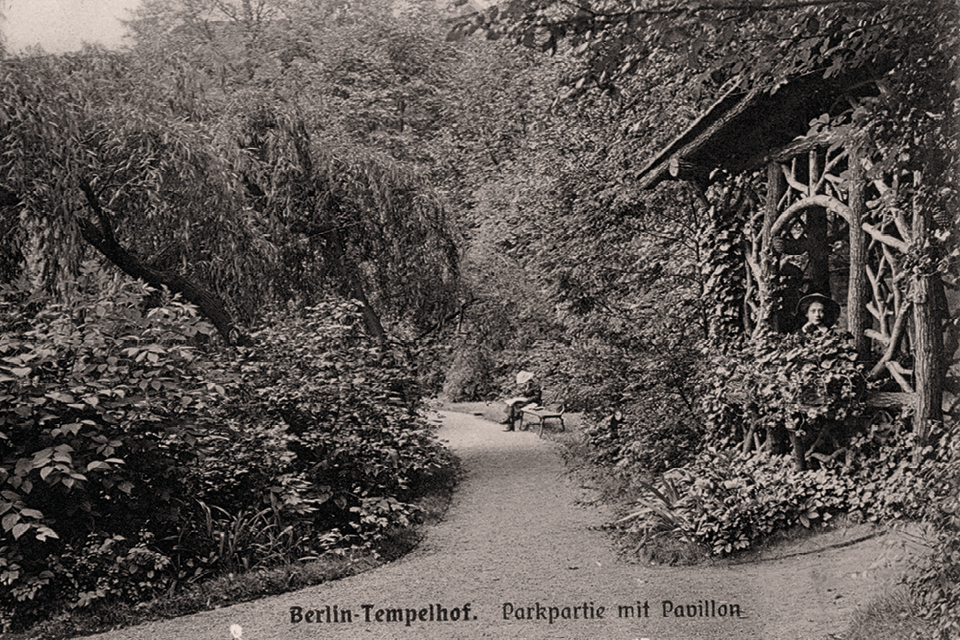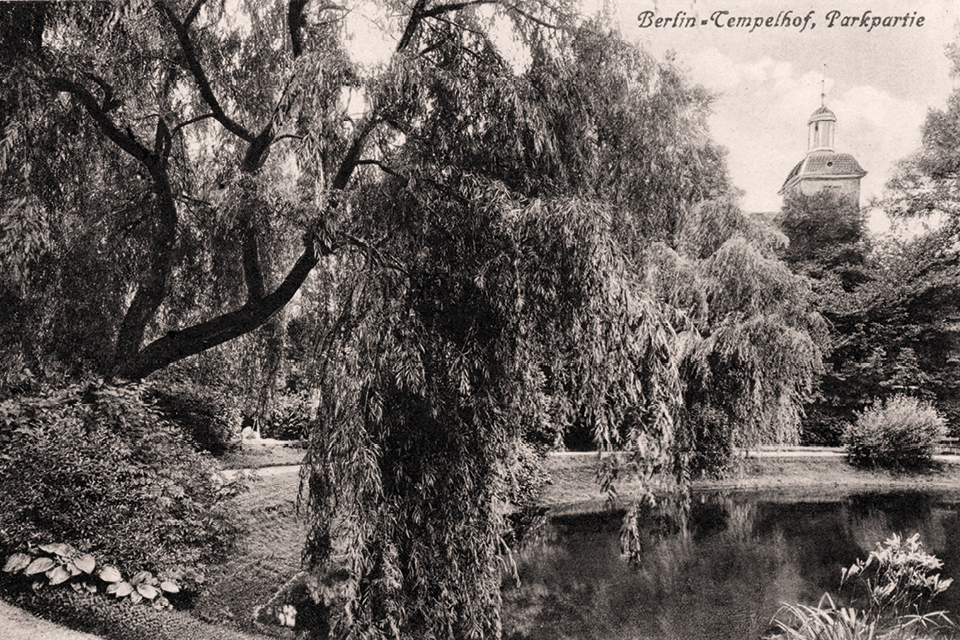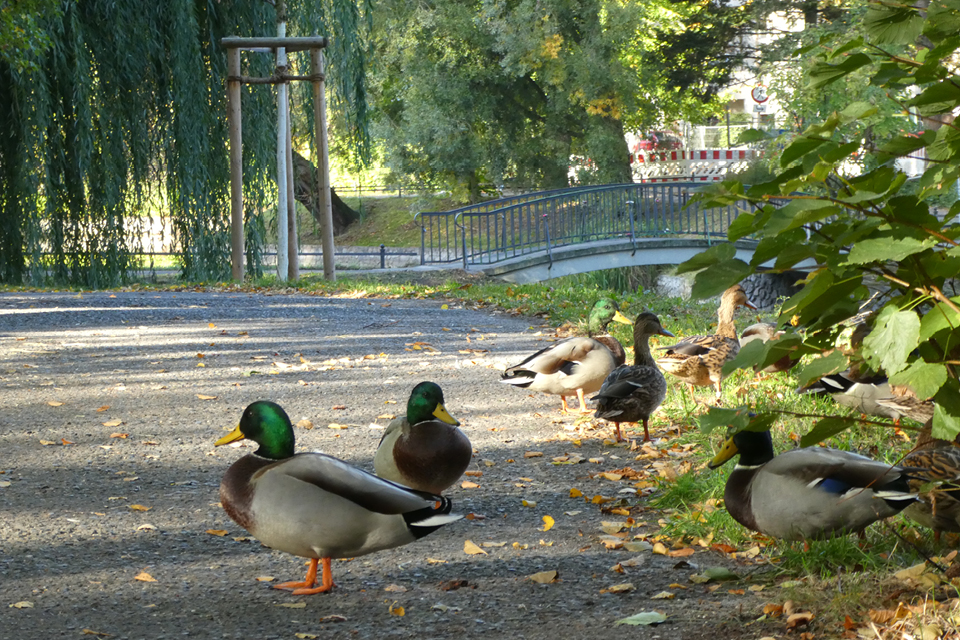Lehnepark
Which animals and plants can be found in the parks? Green spaces as far as the eye can see: the “Alte Park” and “Lehnepark” form a garden monument in the old center of Tempelhof. There is a rich variety of wildlife and plants to discover here.
“City birds sing louder”
Wild animals in the city: Derk Ehlert, an expert on wild animals for the city of Berlin, gives unusual insights into Tempelhof’s fauna and explains how animals adapt to the urban environment.
Audio transcription
Here you will find the podcasts audio transcription >>
“I’m Derk Ehlert, an expert on wild animals in the city of Berlin, and I’d love to tell you something about the animals that live in Lehnepark. Berlin is enormous, with more than 892 square kilometres, and has a lot to offer. It has a lot of people, but also a lot of nature. More than 40% of its area is vegetation, agricultural fields, abandoned lots, parks, woods, lakes and rivers. An enormous city with enormous potential.
More than 20,000 species of animals and plants have been found in Berlin. But in order for them to really live in the city, it’s important to create stepping-stone biotopes or compound biotope systems so the animals and plants can move from A to B. Lehnepark is a great example of a stepping-stone biotope. It connects the big Tempelhof airfield with Francke park, and on the west side with Bose park, and then further west with the green spaces in the garden colony at the Südgelände nature park.
That means Lehnepark is a major refuge for plants and animals. In summer, for instance, you can observe a number of warblers, sometimes even nightingales, buzzards and hawks. And if you walk through the park at dawn or dusk, with a little luck you might spot a fox, marmot or even a raccoon. There are many nocturnal animals in the park too. Bats look for insects in summer, and long-eared owls or even tawny owls come here on a regular basis. It’s quite rewarding to spend time here, regardless of the season, or time of day, or even the night.
Very often in the year you can see a grey heron at one of the lakes here. Grey herons are about as big as storks, with grey-white feathers, and they have become real Berliners. A hundred years ago there weren’t any here, but now they even breed here. One of the largest breeding colonies is in the middle of the city – in a part of the zoo in the Tiergarten park. They regularly come to Lehnepark in search of something to eat, like fish, mice or frogs. In addition to grey herons you can observe coots and rails. These black birds with white beaks have settled at Klarensee. They’re territorial, and sometimes a little quarrelsome. It’s interesting that they can breed more than once a year, and that the young ones of the first generation help the parents raise the second generation. By the way, the rails can fly better than generally assumed. They even roam around the city and can sometimes be found in other parts of the district.
Animals that live in a city have to adapt. The birds, for example, sing considerably louder than their cousins in the wild. They start earlier in the morning and use a somewhat higher pitch so their voices will carry above all the noise, like from Tempelhofer Damm. It’s worth it, in other words, to stop here for a while and enjoy nature in the city. Have a great time!”
Multidimensional Tempelhof







A Tempelhof original
“Lehnepark” might sound like “Lenné Park”, but this idyllic place in Tempelhof was not designed by Prussian landscape artist Peter Joseph Lenné. Neither the park nor the lake had a name before 1980. People simply called it Kleiner Park (“little park”). In 1988, on the 75th anniversary of its acquisition, the park was named in honour of Wilhelm Gottlieb Lehne. A 19th-century landowner in Tempelhof, Wilhelm Lehne was very active in the community. He was a lay judge, local councillor and church elder. When the village of Tempelhof became ever more urbanised at the end of the century, he was the area’s last farmer. The historical building at Alt-Tempelhof 35 was the Lehne family residence. It was located right at the village green, and its extensive property had an area equivalent to 70 football fields. Part of the land was leased to three farms and a church-owned farmstead. Wilhelm Lehne and his wife Maria Lehne are buried in the cemetery of the Tempelhof village church.
Rare plants
Today’s park northwest of the village church belonged to the estate of Wilhelm Lehne. He cultivated a large number of unusual plants here, and it became a popular attraction in Tempelhof. “There was only one of each plant in our park,” said his granddaughter about the remarkable place. The trees here now include poplars, weeping willows, birches, lindens, chestnuts and maples. Reeds on the banks of the Wilhelm pond offer protection to waterfowl, insects and other animals.
Animals in the park
Wilhelm pond in Lehnepark is home and breeding ground to many aquatic birds like coots and mallard ducks, as well as white swans and grey herons. You’ll see lots of birds in the trees and bushes too, such as blackbirds, spotted woodpeckers, robins, wood pigeons, sparrows, nuthatches and blackcaps. Keep an eye out for short-toed treecreepers, nightingales and hawks. As soon as night falls, nocturnal animals like bats and foxes will appear.

